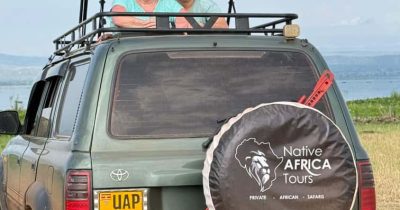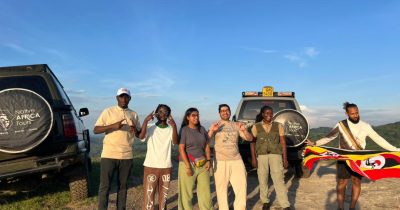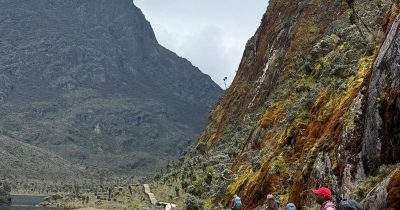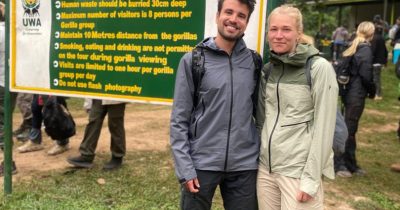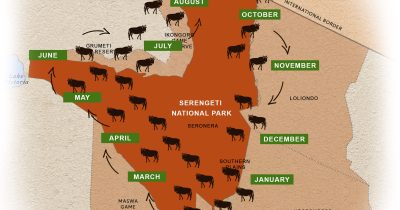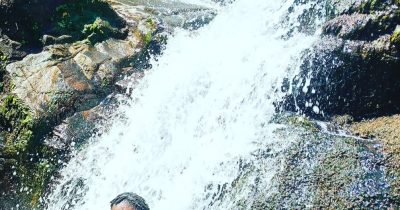Wildebeest Migration in September
A safari to witness the Wildebeest Migration in September offers you an unforgettable experience with the easier predictability of where wildebeest herds can be located. September promises wildlife lovers astonishing sightings of large herds of wildebeests and grazers in the savanna plains of Kenya’s Masai Mara Reserve and the northern section of the Serengeti National Park. Besides, the occasional River crossing shouldn’t be missed in September.

The Masai Mara Migration in September
After most of the wildebeests have crossed the Mara River, they settle in the vast plains of the Masai Mara. They can be spotted as they feed on the fresh green grass. Later, the herds move to the Northern, occupying the Olare Orok and Mara North Private Conservancies. You will also find most of the wildebeests in Nashulai, Oirowua, Nyekweri Oloirien, and more.
A visit to the Maasai Mara in September offers more than a magical migration experience. Expect a diversity of other animals, especially predators such as leopards, cheetahs, and lions. Predators remain active in September, and they are well observed on a game drive during the wildebeest migration.
The Masai Mara Reserve is an endowed ecosystem and experiences hot-dry weather conditions. The dry spell in September is experienced across the Serengeti-Masai Mara Reserve. A section of herds begins returning to the Serengeti, crossing the Mara River.
What else to find in the Masai Mara Reserve
The Masai Mara holds more than wildebeests, and on a migration safari, you stand a chance to come across other wildlife and birds. As you traverse the reserve to witness the Great Migration, expect to encounter other wildlife species, including African bush elephants, rhinos, impalas, waterbucks, sables, gazelles, topis, dik-dik, and zebras.
Bird species are also available for you to spot, along with the diverse wildlife. The common birds in the Masai Mara include little stint, Egyptian goose, Secretary birds, Spur-winged goose, African darters, ostriches, Wahlberg’s eagles, Northern pintail, Verreaux’s eagle, blacksmith lapwing, Abyssinian scimitar bill, European rollers, cinnamon-chested bee-eaters, pied kingfishers, three-banded plovers, green wood hoopoe, white-fronted bee-eaters, flappet lark, Senegal lapwing, and African wattled lapwing, and Golden-tailed woodpeckers.
Serengeti Migration Tour in September
Serengeti National Park is one of the best destinations in East Africa for you to witness the Great Migration. In September, the Northern circuit of Serengeti is the key area of interest for the Migration safari experience. A section of wildebeest herds gathers in the Northern circuit before they start descending towards the South. The southern circuit offers astonishing views of herds returning from the scenic Maasai Mara and the Northern circuit of the Serengeti.
Serengeti National Park is one of Africa’s UNESCO World Heritage Sites and sits on 14,763 sq. km. Visits to Serengeti mainly focus on the Great Migration, an excellent opportunity to watch over 2 million wildebeests, 1000s of zebras, and gazelles. Getting to Serengeti for your Migration safari involves spending about 6-7 hours when driving from Arusha City.
Where to Stay during Wildebeest Migration in September
The major accommodation choices for you to consider for overnight during the migration safari in September include Singita Mara Camp, Grumeti Migration Camp, Serengeti Kati Kati Tented Camp, Four Seasons Safari Lodge, Lobo Wildlife Lodge, Melia Serengeti Lodge, Serengeti Sopa Lodge, and Mara River Camp. Other accommodation alternatives include Mara Serena Safari Lodge, AndBeyond Kichwa Tembo Tented Camp, Karen Blixen Camp, Mara Sopa Lodge, and Soroi Mara Bush Camp, and many more.
What awaits you on the wildebeest migration in September?
Amazing insights to expect on the migration tour in September include witnessing mega-herds in the Masai Mara and some herds in the Serengeti’s Northern circuit. Predators are a must-see on a migration safari in September, and they can be seen across the Serengeti-Mara ecosystem.
How to Experience the Wildebeest Migration in September
Game drives offer a unique opportunity to witness the Migration across the Serengeti-Mara ecosystem. A 4×4 tourist car is a suitable option for traversing the Serengeti and the Masai Mara on a migration tour. In a 4×4 safari vehicle, the main areas to look for wildebeests include the Northern Serengeti and the Masai Mara (the Mara River). As you plan to embark on a game drive tour to observe the wildebeest migration, ensure that you choose places to stay wisely.
The safari lodges and camp options to consider for overnight stays should be booked in the Kogatende/Lamai region. These areas offer an excellent opportunity to observe the Mara River crossings.
Tips to take note when planning a migration safari in September
Book your migration vacation in advance. Due to the high demand, your migration safari must be secured early before September. Booking a tour in advance allows you to secure a slot, ideal accommodation (camps/lodges) for your stay, and means of getting to your favourite migration safari destination.
Book the right accommodation (safari lodge and camps). You should secure a place to stay at a location where you can easily connect and enjoy the wildebeest migration. Talk to a safari expert to plan and book the right safari lodge for your overnight stay on a migration holiday in Kenya/Tanzania.
Pack right for the Migration tour in Kenya/Tanzania. Include essentials such as neutral-coloured clothing that blends with the natural environment, travel documents, binoculars, insect repellent, a camera, a portable charger, a safari hat, sunscreen, and more.
What to do besides the wildebeest migration
In addition to the Great Migration, your African safari in Kenya and Tanzania also offers opportunities for other experiences, including hot-air balloon safaris, cultural safaris, horseback riding, birding, and bush walks. These extra experiences are delightful before or after the wildebeest migration. Cultural experiences across the Serengeti-Masai Mara ecosystem mainly involve close interaction with the Maasai people. The Maasai people/community reside near the Serengeti and Masai Mara. They are known for their distinct traditions and cultures, particularly nomadic pastoralism, as well as beautiful beaded necklaces and other jewellery.
The Great Migration with Gorilla Safaris
Wildebeest migration safaris can also be combined with gorilla trekking experiences. The migration-gorilla trekking tour can be planned and booked through the reliable tour company, Native Africa Tours. A combined migration and gorilla safari allows you to experience the magnificent plains of Tanzania’s Serengeti National Park and Masai Mara in Kenya, then have a spiced wilderness adventure with mountain gorilla trekking. Guided gorilla safari options are available in Uganda and Rwanda.
Gorilla trekking in Uganda primarily takes place in Bwindi Impenetrable National Park and Mgahinga National Park. You can have the best of the Masai Mara and Bwindi combined tour with multiple itinerary options offered by Native Africa Tours. Book our budget-friendly 6 Day Maasai Mara & Gorilla safari package to experience what the savannas and dense African jungle have to provide you with.
Visitors can also book a Masai Mara/Serengeti wildlife tour combined with a Rwanda Volcanoes National Park gorilla safari. We have fantastic offers that combine Kenya/Tanzania migration with Rwanda gorilla trekking tours. Book our captivating 8 Day Serengeti & Rwanda gorilla safari package to experience the unmatched African encounter.
The wildebeest migration in September presents an exceptional opportunity of its own. Want to witness wildebeest herds as they graze or cross back and forth the Mara River? Then book your migration safari with Native Africa Tours.

